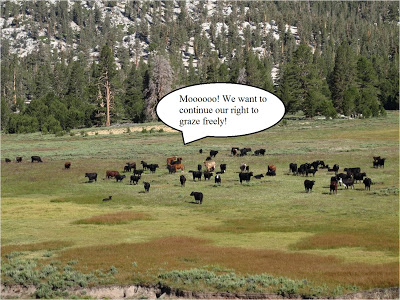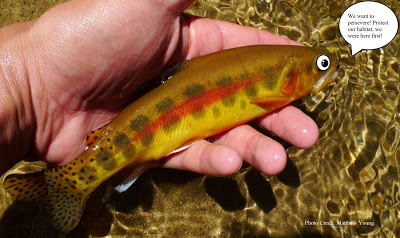

| Visitors Now: | |
| Total Visits: | |
| Total Stories: |

| Story Views | |
| Now: | |
| Last Hour: | |
| Last 24 Hours: | |
| Total: | |
Can we choose between fish and cows?
Read aguanomics http://www.aguanomics.com/ for the world’s best analysis of the politics and economics of water
The federal government has protected the Golden Trout Wilderness (GTW) to preserve natural processes in the eastern Sierra Nevada mountain range of California. The mountains of the GTW cradle verdant meadows and streams that support diverse wildlife, recreation, and economic activities. The meadow streams are the native habitat for the California Golden Trout – California’s state fish and a species of special concern designated by the federal Fish and Wildlife Service due to its rarity. Coincidentally, the meadows are also an ideal environment for wilderness cattle ranching – which represents a longstanding tradition within the minds of many westerners. It is in these meadows that a litigious dispute has surfaced between environmental conservationists aiming to protect native trout habitat, and proponents of cattle grazing. The conflict is over how to best manage the land to serve both people and the environment.
Cattle grazing has occurred in the GTW for over 130 years [pdf]. Every summer, ranchers bring cows into this high country ecosystem through a permit system regulated by the Inyo National Forest. As the cattle graze, they alter trout habitat by devouring native meadow vegetation, trampling and compacting stream banks, and defecating in streams. Scientists have found that these impacts alter golden trout habitat in ways that do not support healthy populations and recruitment. In a habitat study comparing ungrazed areas to grazed areas, scientists Knapp and Matthews found that golden trout were most abundant, with the highest densities and biomasses residing in ungrazed areas (see Knapp and Matthews pdf).
The controversy in GTW centers on what the land managers of the Inyo National Forest should do: Reduce the level of grazing in Golden Trout Wilderness in order to restore golden trout habitat or continue to allow, and even re-open meadows to grazing at the expense of California’s sensitive state fish? Margaret Wood, Inyo National Forest District Ranger, quoted in a Los Angeles Times article, stated that her decision will be based on the “best available science”. While it is imperative for scientists to conduct objective field studies to determine the impacts of disturbance, it is equally important to apply economic analysis when making crucial decisions for land management.
Economic analysis can show whether or not there are more net gains to people from the presence of happy, healthy golden trout swimming around, than there are for people from the continuation of the rights a few individuals have to graze cattle in the GTW. An economist could determine which management activity is worth pursuing by conducting a cost-benefit analysis. The benefits of grazing in GTW include a source of revenue for the Inyo National Forest, a source of income for a few cattle ranchers, and grass fed beef for consumers. The costs entail the environmental damages associated with grazing and none of those costs are currently being covered by the grazing permits. These costs are difficult to determine because of the challenge of assigning a price tag to habitat loss or degradation, monitoring, and the true cost of restoration. However, these costs can be examined through the application of valuation of ecosystem services.
For instance, economist Caroline Alkire has raised the argument that the presence of a large, healthy population of golden trout does and could further generate a source of revenue through the sale of fishing licenses. It could also be argued that, with the absence of cattle, more hikers might frequent the Golden Trout Wilderness, resulting in possible increased revenue to local tourist communities by staying in hotels, dining in restaurants, and promoting businesses. By degrading the habitat in which golden trout thrive, cattle are destroying the potential benefits derived from recreational angler fishing and other visitors to Golden Trout Wilderness.
There are additional benefits derived from the presence of happy, healthy golden trout that are not conveyed in the revenue resulting from recreational fishing or hiking; otherwise known as “use-values”. Many people gain happiness with the knowledge that the golden trout are thriving in a protected environment for various reasons. These “passive values” could be quantified by enthusiastic and creative people interested in determining the best land use practices for society and the environment. The following are these values:
Existence Value: Would the public find pleasure and comfort in the knowledge that GTW provides a place of safety for golden trout? Are people generally indifferent? Or would they prefer cattle ranching continue?
Option Value: Maybe there are anglers or aspiring hikers who hope to one day spend a backcountry adventure in the GTW admiring the beauty of the golden trout.
Bequest Value: Does anyone gain value from the knowledge that future generations will have the golden trout?
Bottom Line: The Forest Service may have scientific proof that grazing causes negative impacts to trout habitat, but until they have more information on how the public values golden trout and un-grazed habitat, they cannot hope to convince the ranchers about the benefits of maintaining golden trout. Until then, they don’t have the right kind of information to find the right level of compromise between conservationists, ranchers, and anyone else who has an interest in the meadows which are home to the last remaining population of California’s state fish.
2012-11-14 09:32:56
Source: http://www.aguanomics.com/2012/11/can-we-choose-between-fish-and-cows.html
Source:




